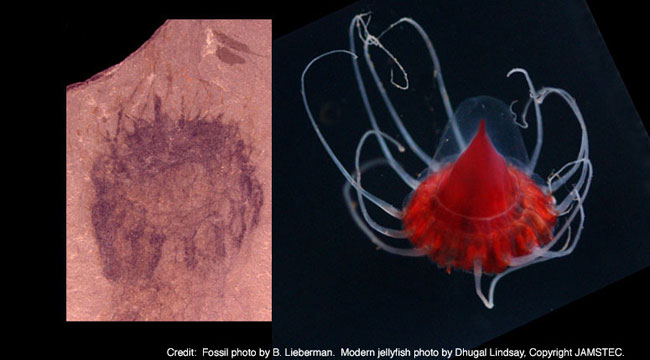Oldest Known Jellyfish Fossils Found

The oldest known fossils of jellyfish have been found in rocks in Utah that are more than 500 million years old, a new study reports.
The fossils are an unusual discovery because soft-bodied creatures, such as jellyfish, rarely survive in the fossil record, unlike animals with hard shells or bones.
"The fossil record is biased against soft-bodied life forms such as jellyfish, because they leave little behind when they die," said study member Bruce Lieberman of the University of Kansas.
These jellyfish left their lasting imprint because they were deposited in fine sediment, rather than coarse sand. The film that the jellyfish left behind shows a clear picture, or "fossil snapshot," of the animals.
"You can see a distinct bell-shape, tentacles, muscle scars and possibly even the gonads," said study team member Paulyn Cartwright, also of KU.
The rich detail of the fossils allowed the team to compare the cnidarian (the phylum to which jellyfish, coral and sea anemones belong) fossils to modern jellyfish. The comparison confirmed that the fossils were, in fact, jellyfish and pushed the earliest known occurrence of definitive jellyfish back from 300 million to 505 million years ago.
The fossils also offer insights into the rapid species diversification that occurred during the Cambrian radiation, which began around 540 million years ago and when most animal groups start to show up in the fossil record, Lieberman said.
Get the world’s most fascinating discoveries delivered straight to your inbox.
The complexity of these early jellyfish seems to suggest that either the complexity of modern jellyfish developed rapidly about 500 million years ago, or that jellyfish are even older and developed long before that time.
- Votes: Creepiest Creatures of the Deep!
- 10 Amazing Things You Didn't Know about Animals
- Images: Rich Life Under the Sea

Andrea Thompson is an associate editor at Scientific American, where she covers sustainability, energy and the environment. Prior to that, she was a senior writer covering climate science at Climate Central and a reporter and editor at Live Science, where she primarily covered Earth science and the environment. She holds a graduate degree in science health and environmental reporting from New York University, as well as a bachelor of science and and masters of science in atmospheric chemistry from the Georgia Institute of Technology.


